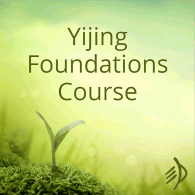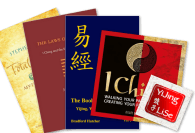a guest article by Mick Frankel
The Basics
Most people know of the I Ching as a book of divination. You ask a question and, most often use either coins or yarrow stalks to end up with a pattern of six lines. Each line is either a solid line (Yang) or a divided line (Yin).
This pattern of six lines is known as a hexagram and there are 64 hexagrams in all. Each hexagram has an overall meaning associated with it. For every hexagram, each of the 6 lines has a specific meaning as well.
Some people, myself included, also read the I Ching as an inspirational book, full of wisdom and insight.
But I’d like to talk about another use of the I Ching. I have found it incredibly useful to analyse organisations and situations by breaking them down into six levels and then working out whether each level represents Yin or Yang energy.
You then end up with a hexagram that represents the organisation. This can give you tremendous insight into what’s going on in the dynamics of any situation.
Source Material
I came across these ideas when I read the book I Ching, The Tao Of Organization by Cheng Yi translated by Thomas Cleary (ISBN 0-87773-419-4).
Cheng Yi was an 11th century educator and activist and his translation and commentary on the I Ching have to do with analysing power and relationships within groups. It is an extraordinary book that, incredibly, fits very well with contemporary management theory.
I think Cheng Yi was someone who really understood the way organisations work. His analysis of the hexagrams is based on representing an organisation as a 6-tier hierarchy and taking each line in the hexagram to represent a level within the hierarchy.
Here’s a quote from Cleary’s introduction:
“The familiarity with the lines, trigrams, and hexagrammatic themes…
enhance the reader’s ability to consult the I Ching by building analytic
hexagrams. This is done by integrating the two basic dialectic processes,
the vertical upper-lower-centre process and the horizontal/vertical yin-yang
process. Concretely, the reader chooses a subject organization, divides it
for the purpose of analysis into an upper echelon and a lower echelon, then
divides each of these into an upper and lower echelon. The central command
is placed in the centre of the top trigram, while the centre of the bottom
trigram represents the mediary between upper and lower echelons. The reader
can also pull out hexagrams singly or in multiples by individual lines or
subsets of a hexagram.
Here are some examples of categories of lines:
- First: workers, peasants, artisans, small independent businesses
- Second: educated and skilled people from among unenfranchised people,
- artists and intellectuals, grass-roots organizers, trade unions
- Third: middle classes, lower and middle management, large local landlords
- and developers
- Fourth: upper managerial levels, academic establishments, functionaries of
- social, cultural, business, and political organizations with
- responsibilities on organisation-wide, national or global scales
- Fifth: central directorates
- Top: the aged, the retired, the emeriti, extremists and diehards”
What each line represents
I’ve tried to apply this method to my own situation at work and to help other people gain some insight into their situations. Here’s my understanding of how it works based on my practical experience of using this technique.
Firstly, break down the organisation into six levels like this:
- Bottom line: Temporary workers, agency staff, students on work experience, interns.In other words, staff who are not a permanent part of the organisation.
- Line 2: Skilled workers, productive staff, the programmers, the machine operators, the workforce proper. The engine-room of the organisation.
- Line 3: Workers representatives, Trade Union representatives. These are people who present the views of the workforce to management. They are often workers themselves with extra responsibilities.
- Line 4: Middle management. The people who report to top-level management but who don’t have the real power in the organisation. They often have the difficult role of mediating between workers and management.
- Line 5: Top-level management. The people who hold the real power in the organisation.
- Top line: People who are not part of the organisation but whose opinion is still valued. Maybe the board of directors, or former managers who’ve retired. This line could also refer to a higher-level such as maybe regional or national bodies.
Having drawn up the six layers of the organisation following these guidelines, you then review each line to see how that level of the organisation sits within the organisation as a whole. For example, is the level represented by the line active or passive, present or absent, having an effect or not having an effect on the organisation overall?
Active/present/having an effect means a Yang line:
![]()
Passive/absent/not having an effect means a Yin line:
![]()
If it’s not obvious, then leave the line open.
But be careful to avoid thinking Yang = good influence, Yin = bad influence. For example, Yang could mean aggressive, over-bearing and inflexible and Yin could mean adaptable, supportive, responsive and flexible.
Worked Example – Now Is Not The Time To Act
Here’s an example from my own department at work.
About a year ago, things were very difficult for me at work. I was in a department of about 100 people. When I joined there were 8 people and the boss was still trying to run it like he had when there were 8 of us. Just giving people work when he felt like it and over-riding all the management structures. My manager was thoroughly professional but very busy with his own technical job and had no time or energy for management. He did whatever the boss said.
I decided to apply Cheng Yi’s method to my own job:
- Bottom line: Yin. There were no graduates or temporary staff in our department. We’d recently had a graduate who didn’t say a word to anyone for 3 months.
- Second line: Yang. This is me and my colleagues knocking ourselves out to keep the show on the road. We often had to use all our skills and experience to find a way through incredible difficult situations that the boss had put us in. We are a very competent technical group who are able to succeed in spite of management!
- Third line: Yin. We had no representatives with any power or responsibility.
- Fourth line: Yin. The middle management were totally passive towards the boss.
- Fifth line: Yang. An autocratic boss held the real power in my department.
- Top line: Yin. The boss would ignore advice and even company guidelines and go his own way.
So, taking the six lines what do we have? Water –
![]()
– below, water above. Hexagram 29 – The Abysmal (Water):
![]()
Now I was in a position to gain an insight into my situation. Here’s the judgement (I’ll use Wilhelm-Baynes translation).
“If you are sincere, you have success in your heart,
And whatever you do succeeds”
That was encouraging. Bear in mind that my job is training manager and I give training sessions and write documentation that’s used all over the world, here’s the image:
“Water flows on uninterruptedly and reaches its goal:
The image of the Abysmal repeated.
Thus the superior man walks in lasting virtue
And carries on the business of teaching.”
My blood froze. Now remember that I saw myself and my colleagues as the second line. Only after reading the judgement and the image do I look at the line which reads:
“The abyss is dangerous.
One should strive to attain small things only.”
Made sense but I also wanted to see if I should try to influence management. Here’s line 3:
“Forward and backward, abyss on abyss.
In danger like this, pause at first and wait,
Otherwise you will fall into a pit in the abyss.
Do not act in this way.”
I think you’ll agree that the advice is clear. I saw that my only hope was to try to perfect my own work and to accept the situation for what it was. There was absolutely no point in trying to change anything and to do so would have been dangerous for me.
One final twist. A colleague of mine was getting really upset and angry at our situation. He wanted to demand a meeting with the manager to confront him and thrash it out. I hope you can see the value of having defined my organisation as Hx 29? I told him that I thought there was no point and that it would be bad for us ultimately if we tried to push things. I told him to just focus on his own stuff and to try to work more and more on improving what he could of his own projects in isolation.
This advice really helped my colleague. (Don’t get me wrong, I’m not like Confucius at work! I didn’t see that it was necessary to say that I’d used an ancient Chinese book to help me to analyse the situation).
Notice that in this process, you don’t actually consult the I Ching for divination. The hexagram is built by consciously analysing the situation. I think this is a very powerful idea.
What emerges is that you can start to see what kind of effect will be produced by changes in the organisation. What eventually happened is that a new level of management was introduced reporting directly to the head of our department. This represents line 4 of the hexagram. This new level of management is heavily involved in trying to change the way things are done.
So, line 4 now becomes Yang making the overall organisation water below,
![]()
lake above,
![]()
hexagram 47, Oppression (Exhaustion).
![]()
Sure enough, the situation has become much worse and morale is at an all-time low.
But, I believe that hexagram 47 represents the very bottom of a cycle and that things will start to improve slowly. The autocratic boss can no longer have it all his way and line 5 will start to change to become Yin giving water below,
![]()
thunder above.
![]()
Hexagram 40, Deliverance:
![]()
I hope you can start to see the power of Cheng Yi’s method.
Worked Example – Now Is Definitely The Time To Act
Here’s another slightly different example. A friend of mine was very concerned about her son’s school. She is a powerful person who can communicate her ideas very skilfully and straightforwardly. She didn’t think that the school was dealing adequately with bullying and she felt that her son was being held back in a number of ways. She’d talked to other parents and many agreed with her, although they didn’t think they could do much about it.
My friend was really struggling with the idea of whether to get involved and force the issue with the school.
We tried to analyse the situation and found this:
- Bottom line: Yin. The parents weren’t actively confronting the school about the situation
- Second line: Yin. The teachers weren’t taking responsibility for what was going on
- Third line: Yin. The teachers’ representatives were not involved
- Fourth line: Yin. The deputy-head was very passive towards the head-teacher
- Fifth line: Yang. The head-teacher ran the school in a heavy-handed, over-bearing way
- Top line: Yang. The head-teacher had the support of the regional education authority
This time, taking the six lines we found earth below,
![]()
wind above
![]()
Hexagram 20 – Contemplation (View):
![]()
This is all about looking at a situation and thinking about it but not getting involved.
Now, in this situation my friend represents line 1 of hexagram 20.
Here’s what I read to her from Wilhelm on the judgement for hexagram 20, line 1:
“A man of influence is at hand, but his influence is not understood by the common people. This matters little in the case of the masses, for they benefit by the actions of the ruling sage whether they understand them or not. But for a superior man it is a disgrace.”
She was very struck by the force of the wording. She felt that she was the “man of influence” and that it would be “a disgrace” for her not to get involved.
So we looked at what would change if she took action. Line 1 becomes Yang and the situation changes to Thunder below,
![]()
wind above
![]()
Hexagram 42 – Increase:
![]()
Here’s the overall judgement from Wilhelm:
“It furthers one to undertake something.
It furthers one to cross the great water.”
And the line 1 judgement:
“It furthers one to accomplish great deeds.
Supreme good fortune. No blame.”
I only hope that you can imagine just how powerful this was for my friend. She described the process as “liberating”. It was incredibly useful for her and she took on the situation and helped to initiate amazing changes at the school.
If you feel drawn to Cheng Yi’s ideas, I strongly recommend that you have a go at drawing up the hexagram for your own organisation. It can take half an hour or so but in my experience it’s always worthwhile.
Do These Ideas Correspond With Management Theory?
I said earlier that Cheng Yi’s ideas fit very well with contemporary management theory. Take for example Hexagram 11:
![]()
Heaven below,
![]()
Earth above
![]()
The I Ching says that this represents Tranquillity or Peace because Heaven has descended to Earth. For Cheng Yi this is a very good organisational structure because, “the fifth yin is weak in position of leadership, and corresponds with the second yang below, which represents the wise who are strong and enlightened. So the fifth is able to delegate authority to the wise and obey them…”
On the other hand, what we in the West might think of as a dynamic organisation with Heaven above and Earth below, hexagram 12 –
![]()
– represents Stagnation or Obstruction in the I Ching. Cheng Yi says that in this type of organisation, “… the right Way for developed people is blocked and not carried out.”
I spoke to a friend of mine who works in education in the USA and she said that these ideas fit in with what, at her work, is called “participatory management”. She said it’s highly recommended and highly successful because it helps the workers own the purpose of the institution’s directions and goals. After all, they’re the ones who are directly involved in the outcome.
I introduced another friend of mine to these ideas and a few weeks later he attended a management seminar given by someone who is at the forefront of contemporary management theory in the Health Service in the UK.
My friend was stunned to hear the lecturer talk about “complexity theory” which is apparently breaking new ground in management theory. The lecturer said that the model of the production line worker who is not much more than an automaton no longer fits. In fact, the workers who are dealing either with the process of production or directly with customers are best placed to provide ideas for where the organisation should be heading.
The lecturer said that the ideal situation managers should look for is where they are listening to the workers and allowing the workers to participate more and more in defining their goals. Amazingly, the lecturer went even further by saying that management should serve the workers. They should be at their service.
My friend felt that what he heard in this lecture connected directly to what I’d tried to explain about Cheng Yi’s ideas.
The lecturer also said that the idea of attaining stability in an organisation was not realistic because everything is in a state of continuous change. Instead, the ideal model becomes one of “boundaried chaos”.
I really feel that this fits exactly with the ancient Chinese ideas that are at the heart of the I Ching. Everything is in a state of constant change and if you are able to recognise the time then you know when to act and when to wait.
Cheng Yi The Man
One final thing. As I was reading the book I wanted to find out more about Cheng Yi. A quick search on the Web told me that he and his brother Cheng Hao were highly influential thinkers of their day.
But while his brother was a lovely man who had many followers, Cheng Yi was a prickly, bad-tempered old buzzard that nobody wanted to follow. For some reason (that probably says something about me), I liked Cheng Yi even more after reading that!
If you have any questions or comments on this article please email Mick Frankel
The books Mick uses are available from Amazon in the UK and US – just click a flag for more information.
| The Tao of Organization, Thomas Cleary / Cheng Yi |
 |
|
| I Ching or Book of Changes, Richard Wilhelm/ Cary Baynes |
 |
|









